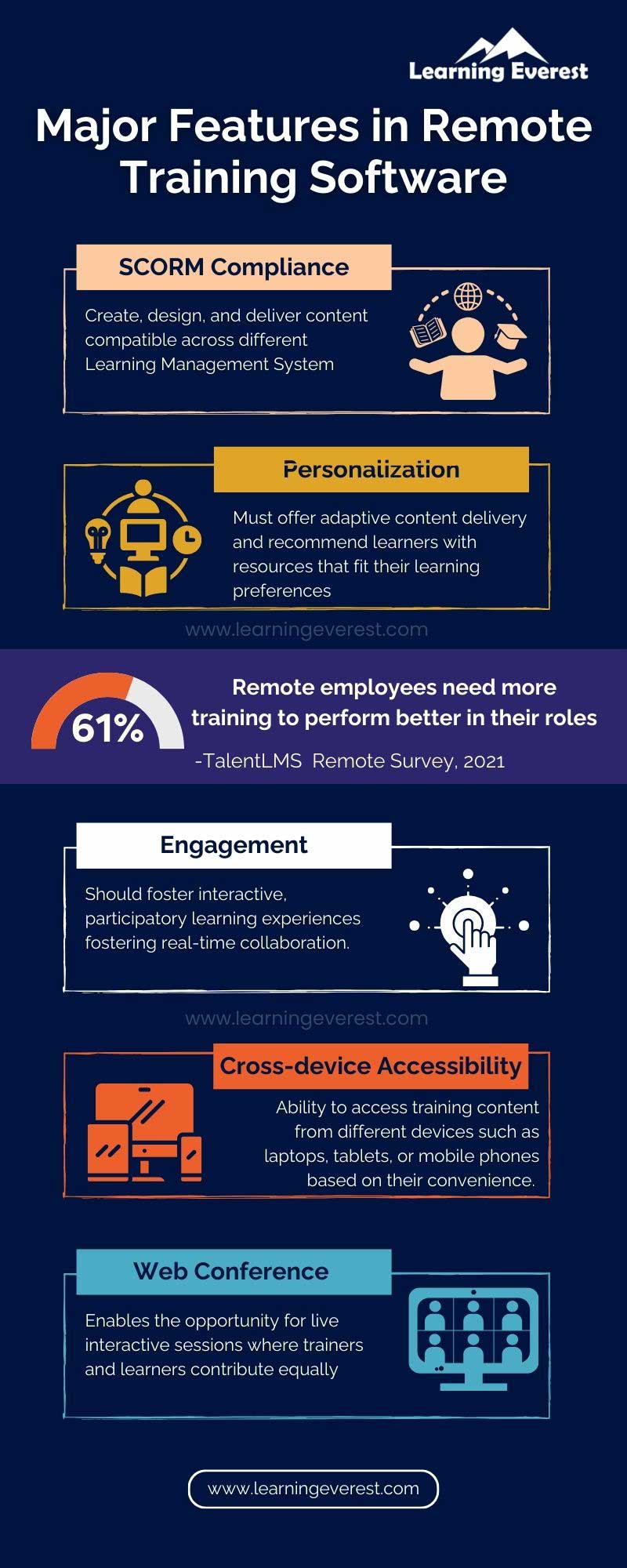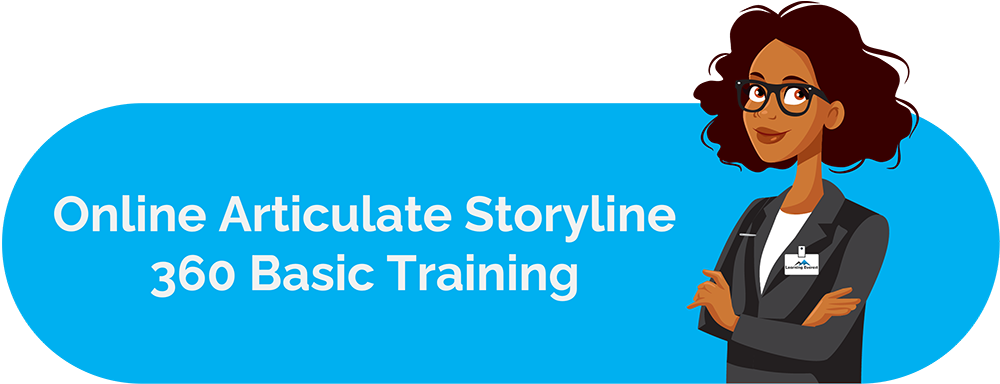Remote Training Software has become the preferred solution for organizations striving to address the rising demand for Learning and Development in the post-pandemic era. With the surge of remote work and flexibility in learning, the role of remote training is paramount. This blog offers significant insights on remote training, the need for remote training software, essential features, and popular remote training software.
Table of Contents
What is Remote Training?
Remote training is a practice of offering instruction to employees to enhance their skills through online or digital platforms. With the convenience, flexibility, and time-saving benefits, the learners benefit profoundly through remote training. The training is conducted synchronously or asynchronously using different modalities. Both remote and hybrid employees prefer remote training over traditional training that incorporates interactive content set on clear objectives. According to the 2021 TalentLMS Remote Work Survey, “61% of remote employees need more training to perform better in their roles.” Furthermore, it ensures team members irrespective of their physical locations attain the knowledge and skills to excel in their professions.
The Need for Remote Training Software
While remote training offers substantial benefits, its true potential is unlocked with the right software, making content easily accessible and engaging for learners. Remote training software is a digital solution that enables organizations to effectively conduct and manage employee training programs remotely. Remote training software is needed in organizations because of the following reasons.

Need For Remote Training Software
Connects Remote Teams
The software connects remote teams to engage in the learning process by offering tools such as virtual classrooms, discussion forums, centralized platforms for resource sharing, and feedback channels. A large number of employees prefer working remotely due to the benefits it offers. For instance, “65% of the workers desire to work remotely all the time.” (Source: Flexjobs). In terms of training offered, these teams benefit from learning in a structured manner according to their convenience using remote training software.
Accelerates Training Completion
Remote training software reduces the training days and encourages fast-paced completion rates. The software offers a catalog of readily accessible content structured in an easy-to-understand manner. This reduces the time spent gathering information from multiple sources in a traditional learning atmosphere. Moreover, the software allows for monitoring the progress of the learning journey along with appropriate feedback from the trainers.
Optimizes budget
Allocating large sums on budgeting for training is a significant concern for organizations. According to the Training Industry Report 2023, training expenditures including travel, training facilities, in-house training development, and equipment “increased in 2023 year to $28.7 billion from $28.3 billion in 2022.” Adopting remote training software minimizes spending on travel costs, facility expenses, and material costs helping businesses to optimize their training budget.
Offers Scalability
Scalability refers to “the ability of a system to accommodate a growing load or demand without compromising performance.” (Source: Geeksforgeeks). In this context, remote training software offers scalability by accommodating a large number of learners and a massive volume of information enhancing performance. The software handles learners and their needs irrespective of the number enabling them access to learning simultaneously. In addition, the software can integrate with other technological tools such as LMS and CRM enabling ease of access.
Remote Onboarding
Onboarding is the practice of integrating newly hired employees into the organization. Onboarding and training are two closely-knit components that orient employees to the workplace. For remote workspaces, the remote training software is a boon as it enables the employees to access onboarding materials despite their physical locations. Furthermore, the software enhances the onboarding process by letting the new hires possess a detailed understanding of their organization at their own convenient pace.
Supports Interactivity
Remote training software supports interactive learning experiences by incorporating simulations, role-plays, scenarios, knowledge checks, gamification, and various multimedia formats. This encourages immersed learning experiences ensuring learner participation and engagement.
Major Features in Remote Training Software
Organizations opt for budget-friendly and scalable remote training software that supports interactive elements. The software should monitor the progress of the training, update learners on their completion rates, and provide assessment and feedback to them. In addition to these features, learning and development professionals opt for certain crucial features in the remote training software.
SCORM Compliance
SCORM stands for Shareable Content Object Reference Model means that the content generated will perform best on every platform. SCORM-compliant remote training software can create, design, and deliver content compatible across different Learning Management Systems (LMS). It offers detailed quantitative insights into the learning progress.
Personalization
Every individual learns differently and has diverse learning needs, styles, and preferences. Remote training software should allow for personalization enabling learners to select courses that fit their interests and goals. The software offering adaptive content delivery and recommending learners with resources that fit their learning preferences is vital. Moreover, professionals prefer software that supports the learning process by sending constant reminders and encompassing content for every learner type.
Engagement
A major apprehension concerning remote training is the lack of real face-to-face communication that can hinder engaged learning. This can be resolved if the software fosters interactive, participatory learning experiences fostering real-time collaboration. The inclusion of live virtual classrooms, chatbots and messaging channels, Q&A sessions, simulations, integration of AR/VR, instant feedback, and interactive elements promote engagement.
Cross-device Accessibility
Accessibility on all devices is a pivotal feature to be considered for remote learning software. Learners access their training content from different devices such as laptops, tablets, or mobile phones based on their convenience. The training software incorporates responsive design with cross-device accessibility ensuring uniformity in layout and features on every device. In addition, professionals prefer software offering offline accessibility enabling learners to download and learn at their convenience.
Web Conference Integration
Web conference integration enables the opportunity for live interactive sessions where trainers and learners contribute equally to the training process. This replicates real classroom situations by offering live workshops, webinars, lectures, and discussions. When traditional sessions require trainers and learners to be physically present at the same place, web conference integration in the remote training software encourages synchronous learning despite geographical locations.
Popular Remote Training Software
To centralize the training process and promote eLearning, mLearning, and blended learning, there are several remote training software with different features and specializations. The famous tools are TalentLMS, EducateMe, Whatfix, Litmos, and Trianual. TalentLMS identifies with the tagline “Train your people anywhere, anytime-and even offline” and offers personalized learning, social learning, monitoring progress, live remote training, and mobile learning opportunities. EducateMe offers collaboration tools, Whatfix has a digital adoption platform, and Litmos creating “a breakthrough in blended learning.” Organizations can adopt the software that fits their training demands and employee requirements.
Conclusion
In a nutshell, remote training is gaining widespread popularity with the convenience, flexibility, and time-saving benefits it provides. Organizations need remote training software to connect with remote teams, accelerate training completion rates, optimize training budgets, offer scalability to a large number of learners, enable remote onboarding, and support interactivity. The major features needed for remote training software are that it should be SCORM compliant, promote personalization depending on the learners, enhance engagement, possess cross-device accessibility, and encourage web conference integration. Depending on the needs and preferences, learning and development professionals in organizations can decide upon the right software to enhance remote learning experiences.
Are you still worried about choosing the best remote training software? Connect with us!
Infographic
Knowledge Check!
Frequently Asked Questions (FAQs)
What is Remote Training?
Remote training is a practice of offering instruction to employees to enhance their skills through online or digital platforms.
What is the need for Remote Training software?
Organizations need remote training software to connect with remote teams, accelerate training completion rates, optimize training budgets, offer scalability to a large number of learners, enable remote onboarding, and support interactivity.
What are the major features of Remote training software?
The major features needed for remote training software are that it should be SCORM compliant, promote personalization depending on the learners, enhance engagement, possess cross-device accessibility, and encourage web conference integration.
What are the popular remote training software?
There are several remote training software with different features and specializations. The famous tools are TalentLMS, EducateMe, Whatfix, Litmos, and Trianual.






